
The South Deccan Plateau dry deciduous forests is a tropical dry forest ecoregion in southern India. The ecoregion lies in the southernmost portion of the Deccan Plateau, and includes the southernmost portion of the Eastern Ghats.

Anogeissus is a genus of trees in the family Combretaceae. The 10 to 12 species are distributed in Asia and tropical Africa. Plants of the World Online now refers to this genus as a synonym of TerminaliaL.

The Narmada Valley dry deciduous forests are a tropical dry forest ecoregion of central India. The ecoregion lies mostly in Madhya Pradesh state, but extends into portions of Chhattisgarh, Maharashtra, Karnataka and Uttar Pradesh states.
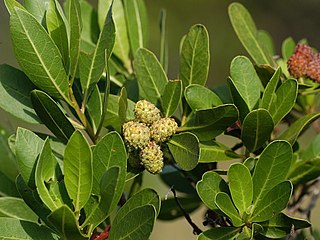
Conocarpus is a genus of two species of flowering plants in the family Combretaceae, native to tropical regions of the world. One of the species is a widespread mangrove species, and the other is restricted to a small area around the southern Red Sea coasts, where it grows alongside seasonal rivers.
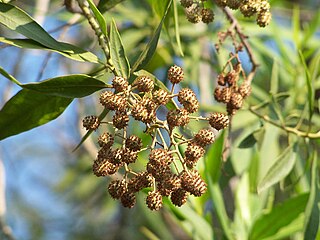
Conocarpus lancifolius, one of two species in the genus Conocarpus, is a tree in the family Combretaceae native to coastal and riverine areas of Somalia, Djibouti, and Yemen. It is found throughout the Horn of Africa, the Arabian peninsula, and South Asia.
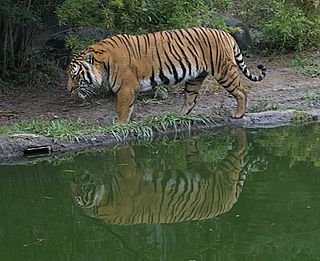
The wildlife of Laos encompasses the animals and plants found in the Lao People's Democratic Republic, a landlocked country in southeastern Asia. Part of the country is mountainous and much of it is still clad in tropical broadleaf forest. It has a great variety of animal and plant species.

Boswellia sacra, also known as Boswellia carteri and others, and commonly called the frankincense tree or the olibanum tree, is a tree in the genus Boswellia, in the Burseraceae family, from which frankincense, a resinous dried sap, is harvested. The olibanum tree is plant native to the countries of Oman and Yemen, in the south of the Arabian Peninsula, and to Somalia, in the Horn of Africa.
Anogeissus bentii is a species of plant in the Combretaceae family. It is endemic to the fog woodlands of Yemen.
Gymnosporia dhofarensis is a species of plant in the family Celastraceae and is found in Oman and Yemen. It is an intricately branched spiny shrub or small tree with its leaves arranged alternately or clustered on short shoots. The flowers have white or cream petals and the fruit are purple or red. It is threatened by habitat loss.
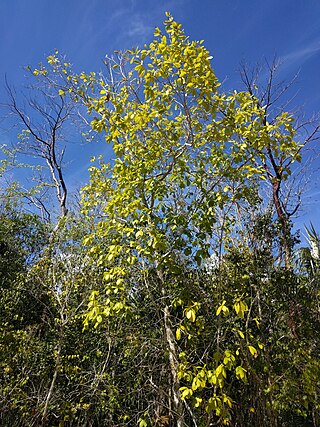
Terminalia eriostachya, the black mastic, is a species of flowering tree in the leadwood family, Combretaceae. It is endemic to Cuba and the Cayman Islands. It is threatened by habitat loss.
Terminalia ivorensis is a species of tree in the family Combretaceae, and is known by the common names of Ivory Coast almond, idigbo, black afara, framire and emeri.
Terminalia reitzii is a species of plant in the Combretaceae family. It is endemic to Brazil, growing primarily in seasonally dry tropical forests in the southern part of the country. It is threatened by habitat loss.

The Arabian Peninsula coastal fog desert, also known as the Southwestern Arabian coastal xeric scrub, is desert ecoregion on the southern coasts of the Arabian Peninsula, which experiences thick fogs where visibility may be reduced to 10 metres (33 ft). It is classed as an Afrotropical fog desert

Jiddat al-Harasis (Jiddat-il-Harasiis) is a stony desert in south-central Oman, separating northern Oman from Dhufar. The largest strewn field of meteorites in the country is situated here. Over 160 bird species, including the endangered houbara bustard, are found here, as well as Arabian oryx and Arabian gazelle. The area was not permanently inhabited until the 19th century with the arrival of the Harasis.
The wildlife of Yemen is substantial and varied. Yemen is a large country in the southern half of the Arabian Peninsula with several geographic regions, each with a diversity of plants and animals adapted to their own particular habitats. As well as high mountains and deserts, there is a coastal plain and long coastline. The country has links with Europe and Asia, and the continent of Africa is close at hand. The flora and fauna have influences from all these regions and the country also serves as a staging post for migratory birds.

The wildlife of Oman is the flora and fauna of this country in the southeastern corner of the Arabian Peninsula, with coasts on the Gulf of Oman and the Arabian Sea. The climate is hot and dry, apart from the southeastern coast, and the country offers a variety of habitats for wildlife including mountains, valleys, deserts, coastal plains and sea coasts.

Sterculia africana or African star-chestnut is a deciduous tree, belonging to the genus Sterculia and the family Malvaceae. The species is sometimes called the "mopopaja tree". It is distributed throughout Northeast Africa to Arabia.
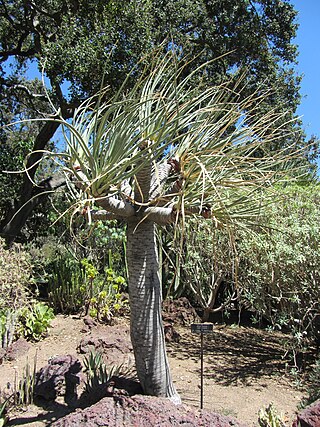
Dracaena serrulata also called the Arabian or Yemen Dragon Tree is a distinctive tree reaching around 5m tall with a single trunk. It is found in the dry escarpment mountains of southwestern Arabia from Oman, South Yemen and Saudi Arabia.

The Southwestern Arabian foothills savanna, also known as the Southwestern Arabian Escarpment shrublands and woodlands, is a desert and xeric shrubland ecoregion of the southern Arabian Peninsula, covering portions of Saudi Arabia, Yemen, and Oman.

The South Arabian fog woodlands, shrublands, and dune is an ecoregion in Oman and Yemen. The fog woodlands lie on mountainsides which slope southeastwards towards the Arabian Sea. The mountains intercept moisture-bearing winds from the Arabian Sea, creating orographic precipitation and frequent fogs that sustain unique woodlands and shrublands in a desert region.















